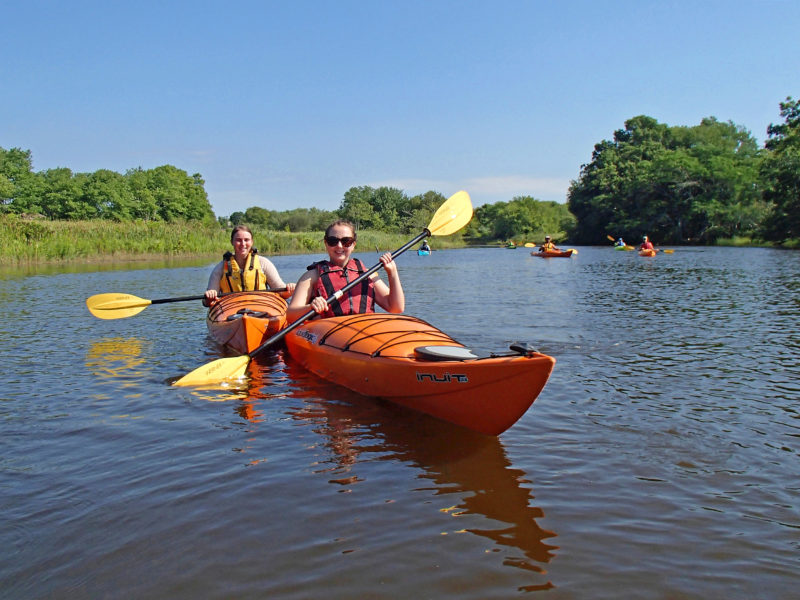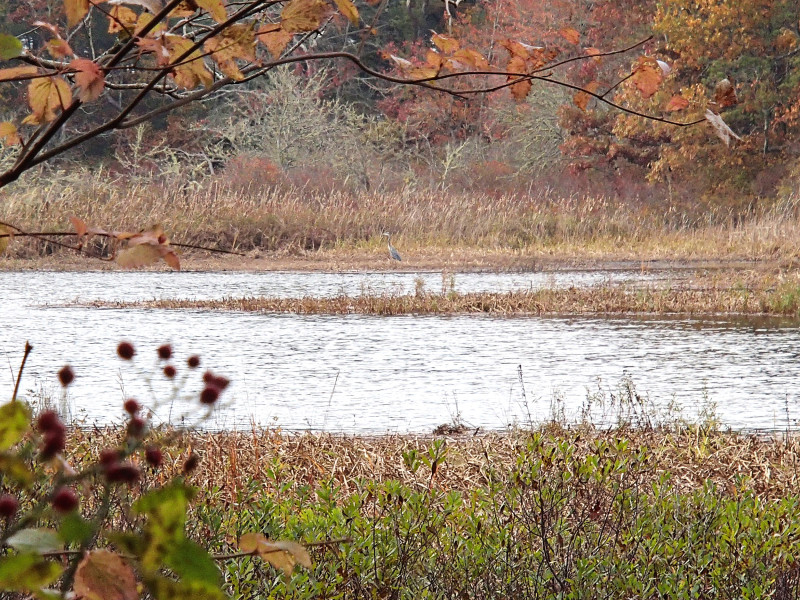An expert’s guide to paddling Buzzards Bay
Samantha Ladd has explored all over the world by paddle: from Colorado’s white waters to the aqua blue of the Caribbean, across the Atlantic in Greece, Portugal, and Croatia, and along the West Coast from Mexico to Washington state. Yet Ladd, the co-founder of Osprey Sea Kayak Adventures, decided to put down roots in Westport, where she spends her days exploring and guiding paddlers among the rivers, harbors, salt marshes, and exposed shores of Buzzards Bay.
“We are so lucky here, truly,” Ladd says. “We have so much to explore. It’s more of a question of, where can’t I go?”

Samantha Ladd, co-founder of Osprey Sea Kayak Adventures, loves that Buzzards Bay has places for people of all skill levels to paddle.
At Osprey, Ladd teaches coastal kayaking, surf kayaking, and stand-up-paddleboarding (SUP) and coordinates custom tours. She says the best thing about paddling around Buzzards Bay’s waterways is that it’s “as relaxing or as wild as you’d like to experience.”
“Whether it’s introducing 10-year-old kids to their first experience, to taking more advanced folks looking to surf a sea kayak or unlock rock gardens along the coast, to just floating down the river and checking out ospreys, we’re able to have all of those experiences here.”
How can I get started paddling around Buzzards Bay?
According to Ladd, the number one error that new paddlers make is buying a boat without researching the boat that’s right for them. Make sure to buy a boat that is the right size for your height and weight, Ladd says, and choose a boat that fits the type of paddling you plan to do. A local outfitter can help you with this.
After that, Ladd recommends starting with the basics: learn the foundations of how to move your boat, and then practice paddling in calm places. As you get comfortable, progress to waters with wind, waves, and currents and see how your boat moves in those conditions. She also recommends getting some instruction, either from an experienced friend or an introductory course.

Join a class with friends to get a more comfortable introduction to paddling.
“Like anything else, there’s a lot to learn, and then you need to practice those things in order to remember them in an unconscious way,” Ladd says.
Ladd’s other suggestion might seem simple, but it can make a huge difference in your comfort and safety: wear the right clothing, including safety flotation. “You may have been canoeing in jeans and flannel shirts and boots your whole life, but that’s not going to be good for kayaking or stand-up paddleboarding,” she says. Ladd recommends wearing warm, waterproof, or water-resistant clothes that are easy to move in. Also, always have a life jacket aboard.
“That emphasis on safety is what we really encourage,” Ladd says. “Because all we want is for paddlers to have fun and have awesome adventures.”
Lastly, Ladd recommends you build a network of experienced local paddlers. Not only will you make new friends to go paddling with, but these experienced paddlers can give you a sense for what a waterway is really like — the location of rocks and mud flats, the best places and times of day to put in, and how wind and tides influence currents. Knowing these details will prepare you to have the best adventures on the waters of your Bay.
Where can I go paddling around Buzzards Bay?
Speaking of adventures: After nearly two decades of paddling around the Bay’s waterways, Ladd has an almost encyclopedic knowledge of where to go if you’re looking for an adventure. Here are some of her favorite places to paddle, based on the type of experience you want. Many of her favorites are in her local Westport and Dartmouth, but we’ve included some more suggestions so you can explore your corner of the Bay.
Relaxing Paddles for Beginners and Families
For younger or inexperienced local paddlers, Ladd recommends Apponagansett Bay in Padanaram, which offers protected waters, good public access, and stellar coastal scenery.
 “The variety around Padanaram gives you a little more to do than just go paddling, when you’re trying to make a day’s adventure or keep the kids entertained,” Ladd says.
“The variety around Padanaram gives you a little more to do than just go paddling, when you’re trying to make a day’s adventure or keep the kids entertained,” Ladd says.
Put in your kayak at the Arthur F. Dias Town Landing and paddle out to Padanaram Harbor toward Ricketsons Point for sweeping Buzzards Bay views. Or, head up Apponagansett Bay toward calmer, quieter waters. Best of all, this family trip comes with a reward: land your boats at Apponagansett Park for an ice cream cone and playtime on the beach and playground before packing up for the day.
For folks outside of Dartmouth, you’ll find similar easy and fun paddling routes on waterways like Mattapoisett Harbor, Sippican Harbor, Megansett and Squeteague Harbors, and West Falmouth Harbor.
Saltwater Kayak Fishing
One of the many things that makes Buzzards Bay special is its abundance of estuaries: places where fresh water flowing downstream from rivers meets the salt water of the Bay. These important habitats are also a great place to catch fish migrating out to sea or chasing bait upstream. Whether it’s the Westport River or the Slocums River, the Wareham River or the Weweantic, Ladd recommends stationing yourself at the river’s mouth near the edge of the open Bay and letting the fish come to you.
Freshwater Paddling and Fishing

Launch a canoe or kayak into Snipatuit Pond from the George E. Wood Memorial Fishermen’s Access Ramp to go fishing for species like largemouth bass, pickerel, and yellow perch.
Kayaks provide an excellent platform for freshwater fishing that won’t scare off the fish! Launch a canoe or kayak from the George E. Wood Memorial Fishermen’s Access Ramp in Rochester to paddle the calm, shallow waters of Snipatuit Pond, where you can fish for largemouth bass, northern pike, chain pickerel, and yellow perch. In Plymouth, explorers and anglers alike will love the deep, crystal-clear waters of Big Sandy Pond, which the Division of Marine Fisheries stocks with trout.
If you’re up for a bit more of an adventure, Ladd recommends launching your boat in Wareham’s Weweantic River — the Weweantic River Boat Ramp is a great place to do so — and paddling upstream. You can start off your fishing trip by catching the striped bass and fluke that swim in these mixed salt and fresh waters. For a bit more variety, paddle up to the dam at Horseshoe Mill and carry your boat over to the other side. On the other side, you’ll find peaceful waters busy with a variety of freshwater fish.
“That involves a bit of legwork – but a lot of these really awesome places involve a little legwork,” says Ladd. “And that sometimes makes a place more special.”
Wildlife Paddles
If you want to spot birds and wildlife, Ladd recommends taking a trip down the Slocums River and up into the Little River. Put in your boat at the top of the Slocums at Russells Mills Landing. Paddle downriver, and you’ll see the landscape change around you as you transition from fresh water to estuary to the river’s dune-lined mouth. This is Ladd’s favorite spot to look for birds — “there’s a different kingfisher every half mile!” she says.

Look for water-loving birds along the edge of the Agawam River, like this great blue heron.
When you reach the river’s mouth, turn back north to head into Little River, where you’ll discover acres of lush salt marshes with almost no human development in sight. Just be sure to check the tides before paddling into Little River; at low tide, paddlers can get stuck on sand bars and mud flats in these shallow passageways.
You’ll find more wildlife-rich paddling if you launch from Seaview Avenue Beach and Boat Ramp to paddle the waters of Nasketucket Bay, or slide your boat into the Agawam River from the Agawam River Trail in Wareham. On the Cape side, launch a kayak from sandy Wood Neck Beach and paddle up into the bird-filled grasses of Little Sippewissett Marsh — just be sure to launch at high tide, as this spot is shallow!
Stand-up Paddleboarding
Stand-up paddleboarding offers a different perspective than a seated kayak adventure. Even if you’ve done some of these routes in a kayak before, you can try them again in a paddleboard to see the Bay in a whole new way.
 There are lots of calm, protected waterways around Buzzards Bay that make for great stand-up paddleboarding, especially if you’re just getting started: try out Onset Bay in Wareham and Little Bay in Bourne, or launch from West Famouth Harbor Landing to explore the nooks and crannies of Snug Harbor. If you’re in the Fairhaven area, Little Bay Conservation Area offers superb access to calm waters surrounded by salt marshes and dotted with islands.
There are lots of calm, protected waterways around Buzzards Bay that make for great stand-up paddleboarding, especially if you’re just getting started: try out Onset Bay in Wareham and Little Bay in Bourne, or launch from West Famouth Harbor Landing to explore the nooks and crannies of Snug Harbor. If you’re in the Fairhaven area, Little Bay Conservation Area offers superb access to calm waters surrounded by salt marshes and dotted with islands.
For more experienced SUP-ers who are comfortable wearing a wetsuit and paddling into open water, Ladd recommends exploring the area around Mishaum Point in Dartmouth. Her favorite time to visit is in winter and early spring, when there are still migratory seals on the rocks.
“Somehow it’s different than when I’m in kayak — I think because I’m wearing a wetsuit, I kind of look like a big seal,” Ladd says. “I can paddle right up to the seals and hang out with them, they’re not intimidated at all by me.”
Longer Trips and Challenges
Want to spend a whole day out on the water? One of Ladd’s favorite local circuits is to put in a kayak at the mouth of the Westport River, where you’ll paddle through rich salt marshes — and Ladd’s favorite spot to fish for striped bass — before emerging along the sandy edge of Horseneck Beach State Reservation. Circle around Gooseberry Neck to surf some larger swells, and then continue along the beach at Allens Pond Wildlife Sanctuary for spectacular views and great birding opportunities.
If you’re on the Cape side of the Bay, launch your boat at Massasoit Avenue Boat Ramp to explore Red Brook Harbor. Paddle around propeller-shaped Bassets Island and along the rocky edge of Scraggy Neck before heading out along the coast. Head north to explore along Wings Neck, and end your trip at picturesque Little Bay and Monks Park. Just be sure to watch out for boat traffic on your way – Red Brook’s two marinas attract a number of boaters, and the open waters here are full of boats from Red Brook Harbor’s two marinas.
If you’ve explored every place in this guide and you’re still looking for more, Ladd has a simple answer: “Ask people that paddle!” You can also check out our guide to 5 paddling routes around the Bay.